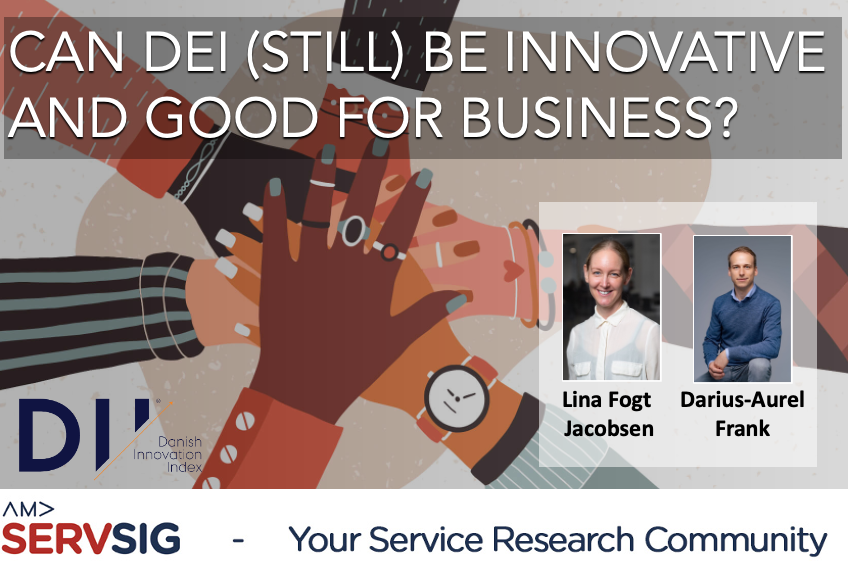Guest article by Lina Fogt Jacobsen and Darius-Aurel Frank. If you are also interested in the field of company innovativeness, please consider submitting to the upcoming special issue in the Journal of Service Management (JOSM).
The DEI balance in a turbulent market
Diversity, equity, and inclusion (DEI) has been an increasing centre of attention in society during the past decade for companies operating on the consumer market. Until recently, many companies have strived towards presenting themselves as diverse and inclusive in order to position themselves as appealing to consumers. Simplified, these companies have reacted to the increasing demands from several consumer groups for more diversity and inclusion in the marketplace. With the recent change in the political scene, several companies have revised their DEI policies to accommodate. For instance, LEGO—a company traditionally positioning itself as highly inclusive—has removed the words “LGBTQ” and “diversity” from their official yearly reports (DR, 2025). We have yet to see empirical evidence for the effects of such roll backs, yet they unmistakenly signal a direction that will likely carry over in various marketing and innovation initiatives of other companies.
Part of the tension around the topic of DEI may be due to its different meanings in different contexts. From a marketing and innovation perspective, a useful definition would be ‘the extent to which the composition of an organisation’s customer base reflects equitable participation especially with respect to traditionally underrepresented, underserved, and marginalised market segments’ (Park, Voss, & Voss, 2023, p. 175). From this perspective, companies can be inclusive by considering both marginalized and mainstream consumers in their marketing and innovation initiatives. In other words, creating value for both. This is of course easier said than done, and while some companies have succeeded in their initiatives (e.g., Mattel’s introduction of barbie with physical disabilities; (Rodriquez-Vila, Nickerson, & Bharadwaj, 2024), other companies also have failed. For instance, Victoria Secret was accused for woke-washing in their attempt to rebrand as inclusive by introducing plus size and transgender models (Guardian, 2023).
DEI as a signal of innovativeness – as perceived by consumers
Should companies care about DEI from a marketing and innovation perspective? Yes, if they care about the general consumer perception of their brand. Traditionally, DEI falls under the umbrella of social innovativeness, where solutions are developed with the purpose of solving social challenges (Gasparin et al., 2021). By contrast, innovativeness has traditionally represented the commercial aspect of innovation by incorporating the company’s ability to be innovative, pioneering, and creative (Kunz, 2024). It is well established in research that the company’s ability to innovate is important from a competitive perspective. Moreover, we know that consumers find companies perceived as commercially innovative more attractive compared to competing offerings (Keiningham et al., 2023; Kurtmollaiev, Lervik-Olsen, & Andreassen, 2022). Findings on the role of social innovativeness in a competitive setting is more blurred—probably due to its lack of direct impact on general consumers and the difficulty of communicating its benefits for the individual. Still, we see a tendency in several markets to value DEI, not only due to a commercial but also a social innovativeness aspect (Jacobsen, Frank, Søndergaard, & Peschel, 2025). This implies that companies can use DEI in their marketing and innovation initiatives to signal both commercial and social innovativeness, thereby increasing their competitive advantage in the eyes of consumers.
DEI on different levels – what counts?
Companies have various possibilities for affecting consumer perceptions of its innovativeness. It may, for instance, initiate changes related to its product or service offerings, the customer experience (online or in the physical store), or its marketing communications (Kurtmollaiev et al. 2022). When it comes to DEI, the area in which it is introduced matters. Moreover, consumers want to see consistency and dedication from the company. A classical failure is to introduce DEI in marketing communications without substantiating it through concrete product and/or service innovations. During the Paralympics 2024, Nike launched a marketing campaign in support of single-leg amputee athletes. At the same time, however, the company refused to sell single shoes to single-leg amputees in general (Guardian, 2024). As in this case, companies run the risk of being accused for woke-washing when their marketing communications are not matched by corresponding product or service innovations. Conversely, when DEI initiatives are consistently implemented across both communication and offerings, companies can strengthen both their perceived social and commercial innovativeness. This alignment is particularly relevant, as it directly shapes consumer perceptions of a company’s attractiveness in the market (Jacobsen et al., 2025).
Behind the numbers: The Danish Innovation Index
The Danish Innovation Index (DII, 2023) is the first consumer-based index assessing firm innovativeness in Denmark and has been established 2021 at the Department of Management, Aarhus University. DII is part of the Innovation Index Coalition (NHH, 2025) and thus rely on a methodology similar to the Norwegian Innovation Index (NII, 2024). Every quarter, a representative sample of Danish consumers’ perceptions of companies—focusing on innovativeness and related constructs—is being collected and has been for the past 5 years. In addition to covering several similar, and thus comparable, measures to the fellow innovation indexes, the DII has adopted various additional measures that allow us to investigate the role of DEI in relation to innovation among companies operating in the Danish consumer market. Denmark is indeed an interesting setting for studying DEI, as it is, in many respects, a highly homogeneous country, ranking 15th on the Global Inclusiveness Index overall. At the same time, however, Denmark scores relatively low on several important inclusiveness parameters, such as religion and disability (InclusivenessIndex, 2024). This contrast makes a particularly interesting research setting for DEI-related initiatives. While it is important to keep in mind that the DII captures the perceptions of general consumers—rather than specifically those of marginalized groups—it has allowed us to derive patterns that underscore the relevance of DEI for general consumers’ perceptions of company innovativeness and to demonstrate that this relationship is more nuanced than first anticipated. Furthermore, DII provides the opportunity to track how companies are performing in their innovation-related DEI initiatives (from a consumer perspective) over time. A top-performer within this category has been LEGO – a company which is also a top performer in perceived commercial and social innovativeness (Figure 1). Another example is Zetland, a digital news platform co-creating with its users, which has also positioned itself strongly on both the social and commercial innovativeness dimensions.

Where DEI and the DII will move next – Future perspective and conclusions
Returning to where we began: Can DEI (still) be innovative and good for business? Our evidence and framework suggest yes—when DEI is coherent, material, and sustained. In turbulent markets, companies face constant pressure to recalibrate and performative signals invite skepticism as to how effective DEI might be; yet, integrated initiatives that connect inclusive intent to actual product and service offerings are a path towards enhancing social and commercial innovativeness as perceived by consumers. For researchers, with policy shifts and corporate rollbacks under way, the next few years translate into fertile ground for studies looking into understanding how DEI initiatives and practices shape company innovativeness. As DII continues to track consumer perceptions for years to come, it helps provide answers to DEI-related questions—empirically rather than rhetorically. Time will tell which firms successfully translate DEI into innovation, which are merely signalling, and how rollbacks affect consumer perceptions over time. In the meantime, for managers, the practical takeaway is straightforward: if your organization believes that perceptions of its consumers matter, match the message with the actions as evidence shows that DEI communications grounded in real offering changes remains a path to being seen as both inclusive and innovative.
If you are also interested in the field of company innovativeness, we would like you to consider submitting to the upcoming special issue in the Journal of Service Management (JOSM). More information here.
Portrait about the authors: Lina and Darius-Aurel
Lina Fogt Jacobsen is an Associate Professor at the Department of Management, Aarhus University. Her research focuses on consumer behavior and marketing, with particular attention to technology adoption, online interactions, and diversity, equity and inclusion. She is co-founder and lead of the Danish Innovation Index, an initiative that for the past five years has provided consumer-based insights into firm innovativeness in the Danish market. Through this work, she contributes to the service research community’s understanding of how consumer perceptions shape and are shaped by service and innovation practices. Most recently, she co-authored From Diversity to Distinction: Exploring the Role of Diversity and Inclusion Related to Consumer Perceptions of Company Innovativeness and Attractiveness (Journal of Business Research, 2025), which demonstrates how D&I initiatives influence consumer perceptions of innovativeness and attractiveness.
Darius-Aurel Frank is an Associate Professor at the Department of Management, Aarhus University, and Research Affiliate at the Erasmus Centre for Data Analytics, Rotterdam School of Management, Erasmus University. He is co-founder of the Danish Innovation Index and founder of the XCB Lab, which explores consumer behavior through experimental AI- and VR-based research. His work bridges behavioral science, service research, and marketing, with a particular focus on how consumers interpret innovation and inclusiveness in service contexts. Most recently, he co-authored The Healthy Aging and Service Firms: The Promise of Smart Technologies (Journal of Service Management, 2025) (Wirtz, Bateson, Caic, Frank, & Veflen, 2025), which highlights how service firms can use AI and smart technologies to create value for aging consumer segments.
- DII. (2023). Danish Innovation Index https://mgmt.au.dk/dii.
- DR. (2025). ‘LGBTQ’ og ‘diversitet’ er forsvundet fra Legos årsrapport https://www.dr.dk/nyheder/indland/lgbtq-og-diversitet-er-forsvundet-fra-legos-aarsrapport.
- Gasparin, M., Green, W., Lilley, S., Quinn, M., Saren, M., & Schinckus, C. (2021). Business as Unusual: A business model for social innovation. Journal of Business Research, 125, 698-709.
- Guardian. (2023). Sorry, Victoria’s Secret, your ‘woke’ rebrand failed because it was performative pants https://www.theguardian.com/commentisfree/2023/oct/22/sorry-victorias-secret-your-woke-rebrand-failed-because-it-was-performative-pants.
- Guardian. (2024). British Paralympian Urges Nike to Introduce Single Trainer Sales https://www.theguardian.com/business/2024/apr/11/british-paralympian-urges-nike-to-introduce-single-trainer-sales.
- InclusivenessIndex. (2024). Inclusiveness Index https://belonging.berkeley.edu/inclusiveness-index/index-results.
- Jacobsen, L. F., Frank, D. A., Søndergaard, H. A., & Peschel, A. O. (2025). From Diversity to Distinction: Exploring the role of diversity and inclusion related to consumer perceptions of company innovativeness and attractiveness. Journal of Business Research, 189, 115184.
- Keiningham, T. L., Aksoy, L., Buoye, A., Yan, A., Morgeson III, F. V., Woodall, G., & Lariviére, B. (2023). Customer Perceptions of Firm Innovativeness and Market Performance: A national-level, longitudinal, cross-industry examination. Journal of Service Research, 0(0), 1-15.
- Kunz, W. (2024). Company Innovativeness – A radically new perspetive on an old concept. Journal of Service Research, 10946705241254744.
- Kurtmollaiev, S., Lervik-Olsen, L., & Andreassen, T. W. (2022). Competing Through Innovation: Let the customer judge! Journal of Business Research, 153, 87-101.
- NHH. (2025). The Innovation Index Coalition (IIC): Amplifying the Customer Voice in Innovation https://www.nhh.no/en/norwegian-innovation-index/our-partners/.
- NII. (2024). Norsk Innovasjonsindeks https://www.nhh.no/en/norwegian-innovation-index/.
- Park, Y. W., Voss, G. B., & Voss, Z. G. (2023). Advancing Customer Diveristy, Equity, and Inclusion: Measurement, stakeholder influence, and the role of marketing. Journal of the Academy of Marketing Science, 51, 174-197.
- Rodriquez-Vila, O., Nickerson, D., & Bharadwaj, S. (2024). How Inclusive Brands Fuel Growth. Harvard Business Review, May-June, 1-14.
- Wirtz, J., Bateson, J., Caic, M., Frank, D. A., & Veflen, N. (2025). The Healthy Aging and Service Firms: The promise of smart technologies. Journal of Service Management, Forthcoming.





